David Hyunchul Shim
Learning from Demonstration with Hierarchical Policy Abstractions Toward High-Performance and Courteous Autonomous Racing
Nov 07, 2024



Abstract:Fully autonomous racing demands not only high-speed driving but also fair and courteous maneuvers. In this paper, we propose an autonomous racing framework that learns complex racing behaviors from expert demonstrations using hierarchical policy abstractions. At the trajectory level, our policy model predicts a dense distribution map indicating the likelihood of trajectories learned from offline demonstrations. The maximum likelihood trajectory is then passed to the control-level policy, which generates control inputs in a residual fashion, considering vehicle dynamics at the limits of performance. We evaluate our framework in a high-fidelity racing simulator and compare it against competing baselines in challenging multi-agent adversarial scenarios. Quantitative and qualitative results show that our trajectory planning policy significantly outperforms the baselines, and the residual control policy improves lap time and tracking accuracy. Moreover, challenging closed-loop experiments with ten opponents show that our framework can overtake other vehicles by understanding nuanced interactions, effectively balancing performance and courtesy like professional drivers.
A Collaborative Team of UAV-Hexapod for an Autonomous Retrieval System in GNSS-Denied Maritime Environments
Oct 12, 2024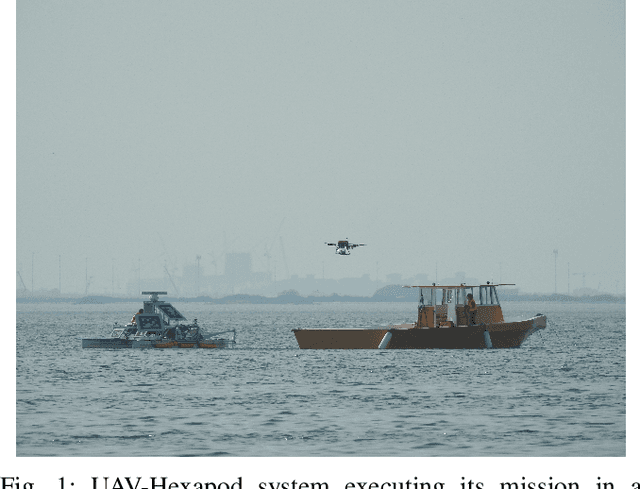
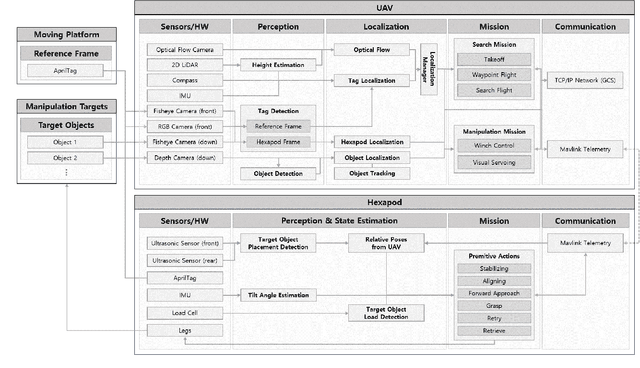


Abstract:We present an integrated UAV-hexapod robotic system designed for GNSS-denied maritime operations, capable of autonomous deployment and retrieval of a hexapod robot via a winch mechanism installed on a UAV. This system is intended to address the challenges of localization, control, and mobility in dynamic maritime environments. Our solution leverages sensor fusion techniques, combining optical flow, LiDAR, and depth data for precise localization. Experimental results demonstrate the effectiveness of this system in real-world scenarios, validating its performance during field tests in both controlled and operational conditions in the MBZIRC 2023 Maritime Challenge.
SPIBOT: A Drone-Tethered Mobile Gripper for Robust Aerial Object Retrieval in Dynamic Environments
Sep 24, 2024Abstract:In real-world field operations, aerial grasping systems face significant challenges in dynamic environments due to strong winds, shifting surfaces, and the need to handle heavy loads. Particularly when dealing with heavy objects, the powerful propellers of the drone can inadvertently blow the target object away as it approaches, making the task even more difficult. To address these challenges, we introduce SPIBOT, a novel drone-tethered mobile gripper system designed for robust and stable autonomous target retrieval. SPIBOT operates via a tether, much like a spider, allowing the drone to maintain a safe distance from the target. To ensure both stable mobility and secure grasping capabilities, SPIBOT is equipped with six legs and sensors to estimate the robot's and mission's states. It is designed with a reduced volume and weight compared to other hexapod robots, allowing it to be easily stowed under the drone and reeled in as needed. Designed for the 2024 MBZIRC Maritime Grand Challenge, SPIBOT is built to retrieve a 1kg target object in the highly dynamic conditions of the moving deck of a ship. This system integrates a real-time action selection algorithm that dynamically adjusts the robot's actions based on proximity to the mission goal and environmental conditions, enabling rapid and robust mission execution. Experimental results across various terrains, including a pontoon on a lake, a grass field, and rubber mats on coastal sand, demonstrate SPIBOT's ability to efficiently and reliably retrieve targets. SPIBOT swiftly converges on the target and completes its mission, even when dealing with irregular initial states and noisy information introduced by the drone.
Skill Q-Network: Learning Adaptive Skill Ensemble for Mapless Navigation in Unknown Environments
Mar 25, 2024Abstract:This paper focuses on the acquisition of mapless navigation skills within unknown environments. We introduce the Skill Q-Network (SQN), a novel reinforcement learning method featuring an adaptive skill ensemble mechanism. Unlike existing methods, our model concurrently learns a high-level skill decision process alongside multiple low-level navigation skills, all without the need for prior knowledge. Leveraging a tailored reward function for mapless navigation, the SQN is capable of learning adaptive maneuvers that incorporate both exploration and goal-directed skills, enabling effective navigation in new environments. Our experiments demonstrate that our SQN can effectively navigate complex environments, exhibiting a 40% higher performance compared to baseline models. Without explicit guidance, SQN discovers how to combine low-level skill policies, showcasing both goal-directed navigations to reach destinations and exploration maneuvers to escape from local minimum regions in challenging scenarios. Remarkably, our adaptive skill ensemble method enables zero-shot transfer to out-of-distribution domains, characterized by unseen observations from non-convex obstacles or uneven, subterranean-like environments.
TempFuser: Learning Tactical and Agile Flight Maneuvers in Aerial Dogfights using a Long Short-Term Temporal Fusion Transformer
Aug 07, 2023Abstract:Aerial dogfights necessitate understanding the tactically changing maneuvers from a long-term perspective, along with the rapidly changing aerodynamics from a short-term view. In this paper, we propose a novel long short-term temporal fusion transformer (TempFuser) for a policy network in aerial dogfights. Our method uses two LSTM-based input embeddings to encode long-term, sparse state trajectories, as well as short-term, dense state trajectories. By integrating the two embeddings through a transformer encoder, the method subsequently derives end-to-end flight commands for agile and tactical maneuvers. We formulate a deep reinforcement learning framework to train our TempFuser-based policy model. We then extensively validate our model, demonstrating that it outperforms other baseline models against a diverse range of opponent aircraft in a high-fidelity environment. Our model successfully learns basic fighter maneuvers, human pilot-like tactical maneuvers, and robust supersonic pursuit in low altitudes without explicitly coded prior knowledge. Videos are available at \url{https://sites.google.com/view/tempfuser}
An Autonomous System for Head-to-Head Race: Design, Implementation and Analysis; Team KAIST at the Indy Autonomous Challenge
Mar 16, 2023Abstract:While the majority of autonomous driving research has concentrated on everyday driving scenarios, further safety and performance improvements of autonomous vehicles require a focus on extreme driving conditions. In this context, autonomous racing is a new area of research that has been attracting considerable interest recently. Due to the fact that a vehicle is driven by its perception, planning, and control limits during racing, numerous research and development issues arise. This paper provides a comprehensive overview of the autonomous racing system built by team KAIST for the Indy Autonomous Challenge (IAC). Our autonomy stack consists primarily of a multi-modal perception module, a high-speed overtaking planner, a resilient control stack, and a system status manager. We present the details of all components of our autonomy solution, including algorithms, implementation, and unit test results. In addition, this paper outlines the design principles and the results of a systematical analysis. Even though our design principles are derived from the unique application domain of autonomous racing, they can also be applied to a variety of safety-critical, high-cost-of-failure robotics applications. The proposed system was integrated into a full-scale autonomous race car (Dallara AV-21) and field-tested extensively. As a result, team KAIST was one of three teams who qualified and participated in the official IAC race events without any accidents. Our proposed autonomous system successfully completed all missions, including overtaking at speeds of around $220 km/h$ in the IAC@CES2022, the world's first autonomous 1:1 head-to-head race.
Data-Driven Model Identification via Hyperparameter Optimization for Autonomous Racing Systems
Jan 06, 2023Abstract:In this letter, we propose a model identification method via hyperparameter optimization (MIHO). Our method adopts an efficient explore-exploit strategy to identify the parameters of dynamic models in a data-driven optimization manner. We utilize MIHO for model parameter identification of the AV-21, a full-scaled autonomous race vehicle. We then incorporate the optimized parameters for the design of model-based planning and control systems of our platform. In experiments, the learned parametric models demonstrate good fitness to given datasets and show generalization ability in unseen dynamic scenarios. We further conduct extensive field tests to validate our model-based system. The tests show that our race systems leverage the learned model dynamics and successfully perform obstacle avoidance and high-speed driving over $200 km/h$ at the Indianapolis Motor Speedway and Las Vegas Motor Speedway. The source code for MIHO and videos of the tests are available at https://github.com/hynkis/MIHO.
Mapless Navigation: Learning UAVs Motion forExploration of Unknown Environments
Oct 04, 2021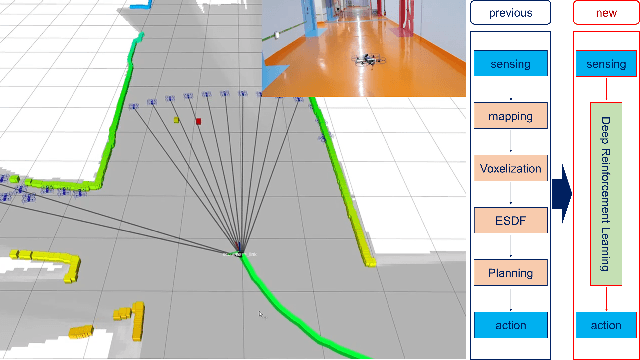
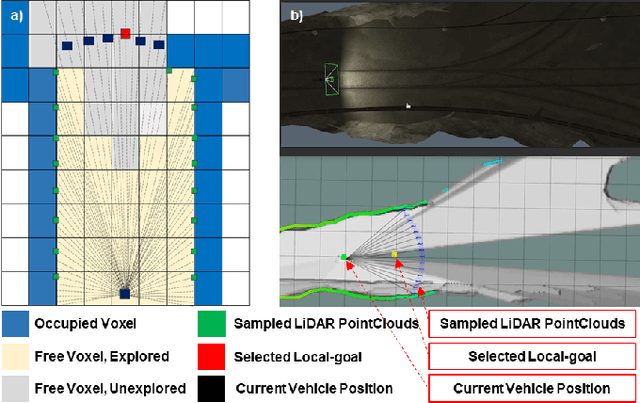
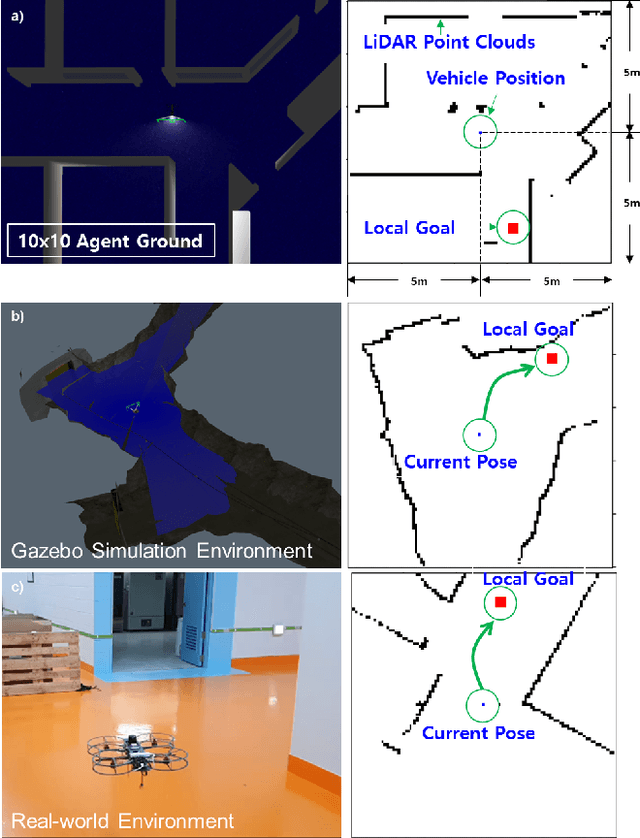
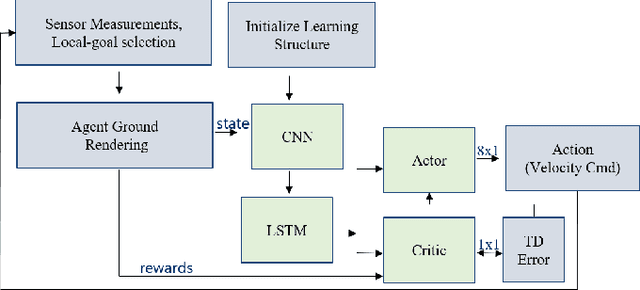
Abstract:This study presents a new methodology for learning-based motion planning for autonomous exploration using aerial robots. Through the reinforcement learning method of learning through trial and error, the action policy is derived that can guide autonomous exploration of underground and tunnel environments. A new Markov decision process state is designed to learn the robot's action policy by using simulation only, and the results are applied to the real-world environment without further learning. Reduce the need for the precision map in grid-based path planner and achieve map-less navigation. The proposed method can have a path with less computing cost than the grid-based planner but has similar performance. The trained action policy is broadly evaluated in both simulation and field trials related to autonomous exploration of underground mines or indoor spaces.
Game-Theoretic Model Predictive Control with Data-Driven Identification of Vehicle Model for Head-to-Head Autonomous Racing
Jun 08, 2021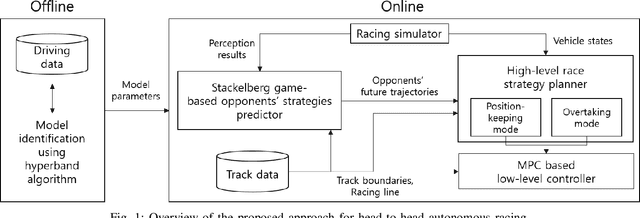
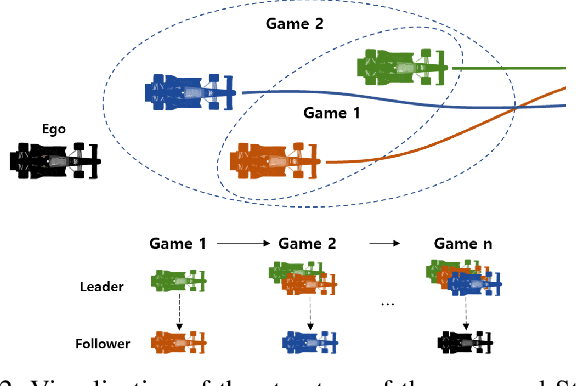
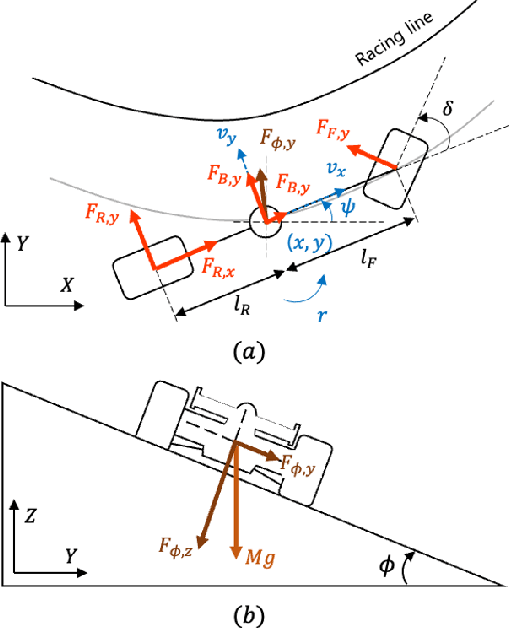
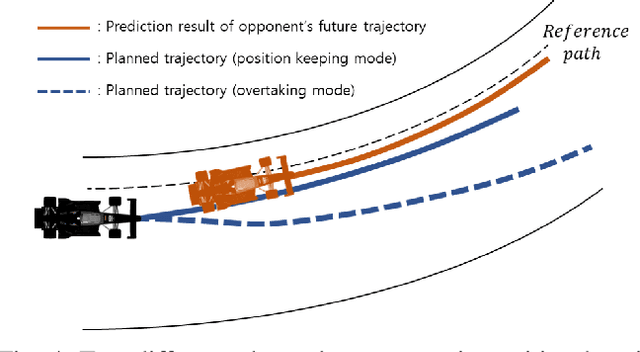
Abstract:Resolving edge-cases in autonomous driving, head-to-head autonomous racing is getting a lot of attention from the industry and academia. In this study, we propose a game-theoretic model predictive control (MPC) approach for head-to-head autonomous racing and data-driven model identification method. For the practical estimation of nonlinear model parameters, we adopted the hyperband algorithm, which is used for neural model training in machine learning. The proposed controller comprises three modules: 1) game-based opponents' trajectory predictor, 2) high-level race strategy planner, and 3) MPC-based low-level controller. The game-based predictor was designed to predict the future trajectories of competitors. Based on the prediction results, the high-level race strategy planner plans several behaviors to respond to various race circumstances. Finally, the MPC-based controller computes the optimal control commands to follow the trajectories. The proposed approach was validated under various racing circumstances in an official simulator of the Indy Autonomous Challenge. The experimental results show that the proposed method can effectively overtake competitors, while driving through the track as quickly as possible without collisions.
Robust Collision-free Lightweight Aerial Autonomy for Unknown Area Exploration
Mar 16, 2021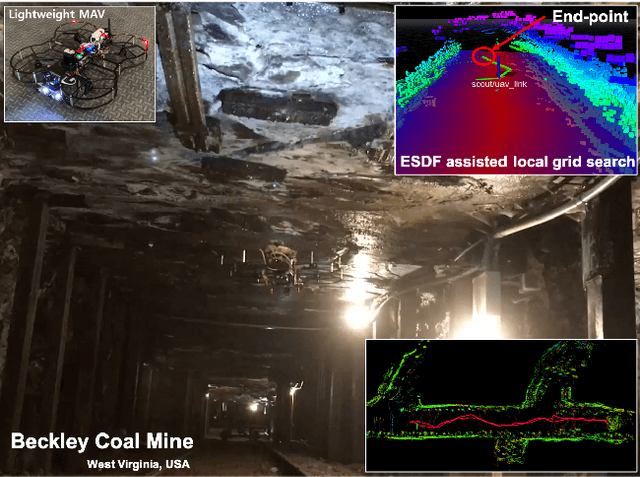
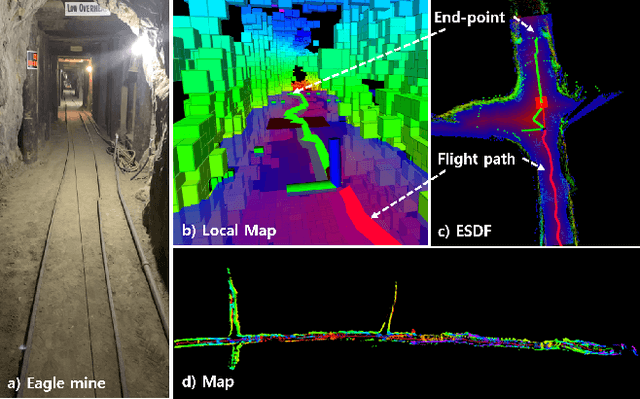
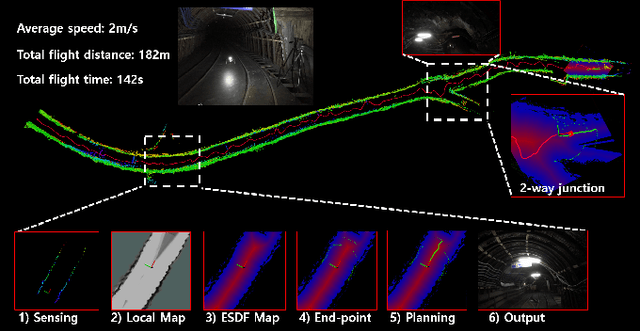
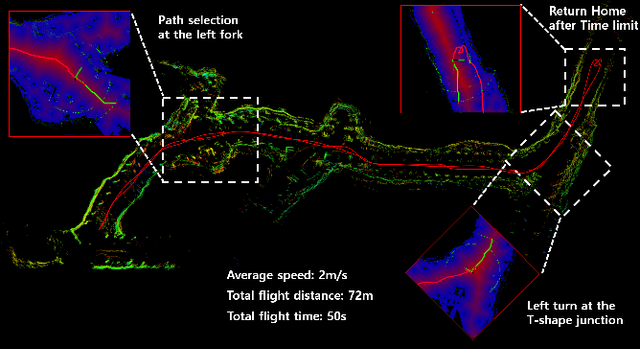
Abstract:Collision-free path planning is an essential requirement for autonomous exploration in unknown environments, especially when operating in confined spaces or near obstacles. This study presents an autonomous exploration technique using a small drone. A local end-point selection method is designed using LiDAR range measurement and then generates the path from the current position to the selected end-point. The generated path shows the consistent collision-free path in real-time by adopting the Euclidean signed distance field-based grid-search method. The simulation results consistently showed the safety, and reliability of the proposed path-planning method. Real-world experiments are conducted in three different mines, demonstrating successful autonomous exploration flight in environments with various structural conditions. The results showed the high capability of the proposed flight autonomy framework for lightweight aerial-robot systems. Besides, our drone performs an autonomous mission during our entry at the Tunnel Circuit competition (Phase 1) of the DARPA Subterranean Challenge.
 Add to Chrome
Add to Chrome Add to Firefox
Add to Firefox Add to Edge
Add to Edge